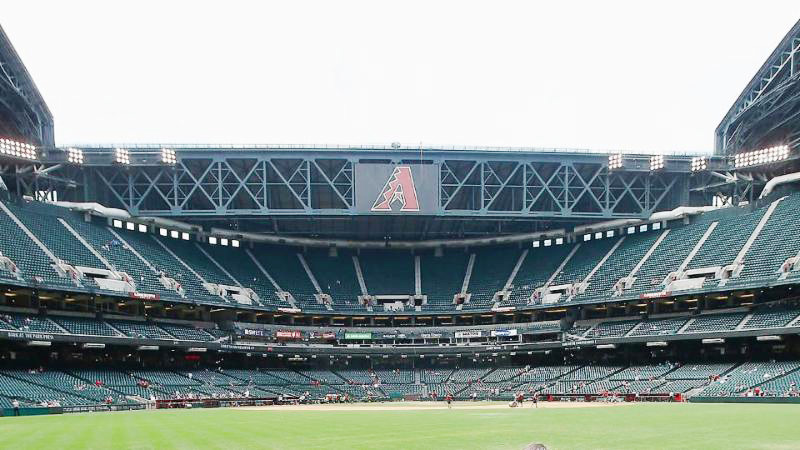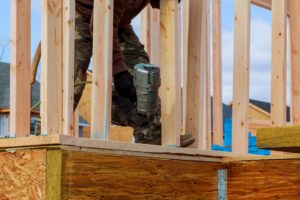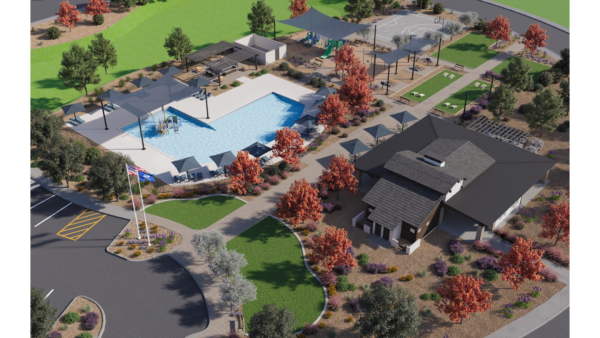By Zach Spedden | Ballpark Digest
Details have surfaced on what the Arizona Diamondbacks would want in a new ballpark project, showing a bold vision for how the team could settle its long-term facility situation.
D-Backs ownership has been evaluating the organization’s future since reaching an agreement with Maricopa County to seek a new home in May 2018, a deal that came amidst dissatisfaction with how Chase Field was being run and maintained. Since then, the organization has been largely quiet on how it is proceeding with its facility planning, but details uncovered in an Arizona Republic report this week outline some of the objectives that could be part of any new ballpark plan.
The wish list for a new ballpark, which was shared with officials in the Las Vegas suburb of Henderson last year, essentially calls for a retractable-roof ballpark built with a more intimate design than Chase Field and anchor a sprawling mixed-use development. Within that development would be amenities like retail, dining, offices and residential units, plus a 5,000-seat concert venue controlled by the D-Backs.

Given that the wish list outlines broad ranges for the scope of the project-such as 45-70 acres for mixed-use development-it seems that the figures could change as negotiations unfold. Additionally, it is worth noting that the wish list itself does not amount to a commitment to build a new ballpark, and the D-Backs have not come out and publicly dismissed the idea of a Chase Field renovation.
Still, any renovation to Chase Field would have challenges to consider. The sprawling footprint of the ballpark is a notable disadvantage, and the D-Backs would have to find a way to make the facility more intimate. Part of that strategy would surely involve scaling back Chase Field’s seating capacity of 48,519 in favor of more social/group spaces, but the D-Backs have notably called for a new ballpark with a slightly smaller footprint than Chase Field-at least 20 acres for a new ballpark, compared to Chase Field’s footprint of about 25 acres-and any effort to downsize the current facility would likely require elaborate construction measures, if it is even feasible.
Furthermore, it is questionable if the team can put together enough land in the area around Chase Field to fulfill the vision of new development. While there is potential for the team to work with some surrounding land in downtown Phoenix, a mixed-use development centered around a renovated Chase Field would likely be completed to a much smaller scale than the low end of the range outlined in the D-Backs’ wish list.
As noted, the D-Backs have had conversations with Henderson officials, who pitched a retractable-roof ballpark surrounded by new development. However, all indications are that conversations between the two sides have stalled, and that the D-Backs are not considering any overtures outside Arizona.
Remaining in the Valley of the Sun could be viable, with East Valley perhaps being a desirable option. Land is available for a new ballpark and mixed-use area with easy freeway access, and the D-Backs are already partners with the Salt River Pima-Maricopa Indian Community on Salt River Fields at Talking Stick, the team’s spring-training home, and perhaps the tribe would be a willing partner on an MLB ballpark on some level.
Politically, there would be challenges to obtaining public funding for a new ballpark, especially given other facility issues in the Valley of the Sun: the City of Phoenix has already committed $150 million from its Sports Facilities Fund to renovate Talking Stick Resort Arena-home of the NBA’s Suns-and the NHL’s Arizona Coyotes are expected to eventually launch an arena search under new majority owner Alex Meruelo. However, the notion of public money in some form should not be dismissed entirely, especially with the state Supreme Court’s decision earlier this year to uphold the legality of using a car-rental surcharge in Maricopa and Pima counties to fund sports facilities.
Maricopa County officials, for their part, seem to believe that they are in a strong position to retain the D-Backs, pointing to a booming local economy. More from The Arizona Republic:
The new Fry’s grocery, thriving tech sector in the warehouse district, new residential buildings and Phoenix Suns’ commitment to stay at Talking Stick Resort Arena show that downtown is a vibrant place, Maricopa County Board Chairman Bill Gates said.
Gates said he thinks once the Diamondbacks look at the other options, “no disrespect to Henderson, they will decide they want to remain in the fastest growing county in the country in the past three years. We think we compare very well.”
Expect discussions involving the D-Backs to heat up in the future. Under the terms of their settlement with Maricopa County, the D-Backs can look for a new home either in the Valley of the Sun or elsewhere after the end of the 2022 season, effectively shaving five years off the Chase Field lease.











